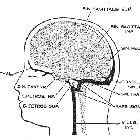Dura mater
The dura mater, also known as the pachymeninx (plural: pachymeninges), is the tough outer layer of the meninges that surrounds the central nervous system and is pierced by the cranial nerves, the internal carotid arteries and the vertebral arteries.
Intracranially, it is formed by two layers:
- outer endosteal layer, continuous via the skull sutures and foramina with the periosteum
- inner meningeal layer, continuous inferiorly with the theca of the spinal cord
These two layers are adherent except where separated by the dural venous sinuses, including the cavernous sinus, which are therefore analogous to the epidural venous plexus of the spinal canal.
As the outer layer is merely the periosteum, it surrounds the cranial bones and therefore extends into the sutures making the dura inseparable from these and thus limiting extradural hemorrhages to the sutures.
With age, the dura becomes thicker and more adherent to the overlying bones, accounting for the lower incidence of extradural hemorrhages in the elderly.
Arterial supply
The inner layer requires little nourishment. Whereas the outer layer is markedly vascular and derives its blood supply from the adherent bone. Arterial supply is therefore dependent on the site of the dura:
- anterior cranial fossa
- anterior meningeal artery (a branch from the anterior ethmoidal artery)
- meningeal branches of the ophthalmic artery
- middle cranial fossa
- middle meningeal artery is the major supply (a branch of the maxillary artery and has anterior and posterior divisions)
- accessory meningeal arteries (branches from the maxillary artery)
- the dura over the cavernous sinuses is supplied by small meningeal branches of the internal carotid and accessory meningeal arteries
- posterior cranial fossa: various blood supply including
- posterior meningeal artery (a branch of the ascending pharyngeal artery)
- meningeal branches from the ascending pharyngeal artery, the occipital artery and the vertebral artery
All these vessels course between the two layers of the dura.
Venous drainage
- occurs via multiple unnamed meningeal veins that drain directly into the dural venous sinuses
Lymphatic drainage
Until 2015 it was thought that the meninges lacked their own lymphatic drainage system, but since the groundbreaking work by Antoine Louveau et al, the details are gradually being teased out, although the precise anatomy of the meningeal lymphatic drainage system remains incomplete .
Innervation
Like the arterial supply, innervation is dependent on the site of the dura:
- the dominant nerve supplying most of the supratentorial dura is the tentorial nerve (a branch of the ophthalmic nerve (CN Va) which supplies the falx cerebri, calvarial dura and superior surface of the tentorium cerebelli.
- anterior cranial fossa
- anterior meningeal branches from the ethmoidal nerves (CN Va)
- meningeal branches from the maxillary nerve (CN Vb)
- middle cranial fossa
- middle meningeal nerve which is a branch of the nerve (CN Vb) supplies the anterior half of the fossa
- nervus spinosus which is the meningeal branch of the mandibular nerve (CN Vc) supplies the posterior half of the fossa
- posterior cranial fossa
- sensory branches from the vagus nerve (CN X) and glossopharyngeal nerve (CN IX) supply the inferior surface of the tentorium and dura of the posterior fossa
- small sensory branches of the C1 to C3 dorsal rami supply around the foramen magnum
History and etymology
"Dura mater" derives from the medieval Latin "durus" and "mater", i.e. "hard mother". This term was created by the Italian scholar, Stephen of Antioch (fl. 12 century) when he translated a work by the Persian physician Haly Abbas in the 12 century . Islamic medicine at that time conjectured that the meninges gave rise to all the membranes of the body and expressed relationships between different tissue types in terms of familial relationships (mother, son, daughter, etc.).
Siehe auch:
- Arteria carotis interna
- Arteria vertebralis
- Sinus durae matris
- epidurales Hämatom
- Hirnnerven
- Leptomeningen
und weiter:
- Pacchionische Granulationen
- Tentorium cerebelli
- Nervus olfactorius
- Nervus opticus
- Meningeom Nervus opticus
- meninges
- Nervus oculomotorius
- meninx primitiva
- Nervus hypoglossus
- Nervus petrosus minor
- cerebral venous system
- spinale meningeale Zysten
- Klassifikation spinaler meningealer Zysten nach Nabor
- Sinusthrombose bei otogenen Infektionen
- meningeale Blutversorgung
- Jacobson-Anastomose
- Nervus petrosus major

 Assoziationen und Differentialdiagnosen zu Dura mater:
Assoziationen und Differentialdiagnosen zu Dura mater:




